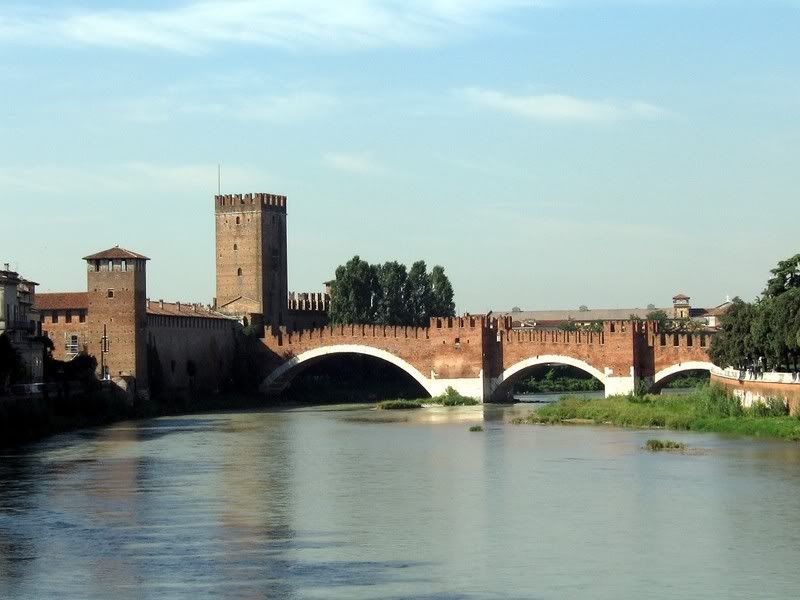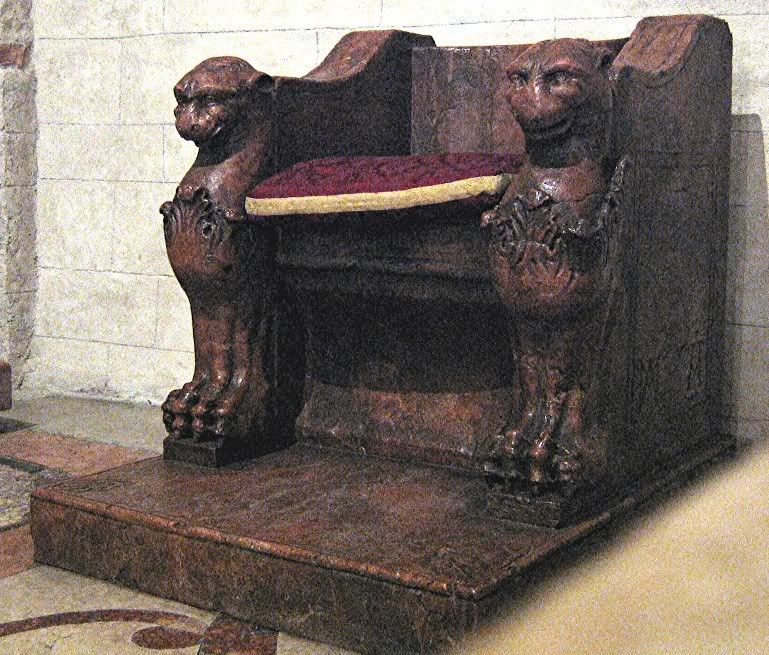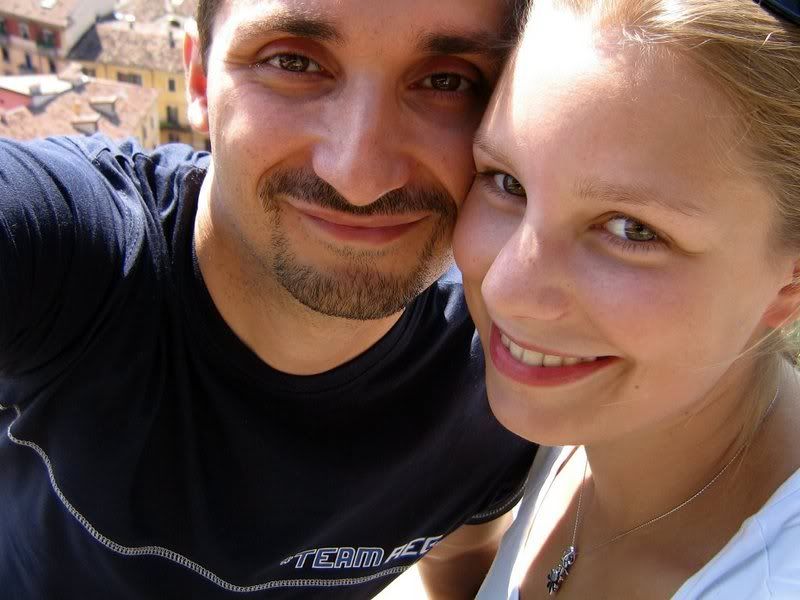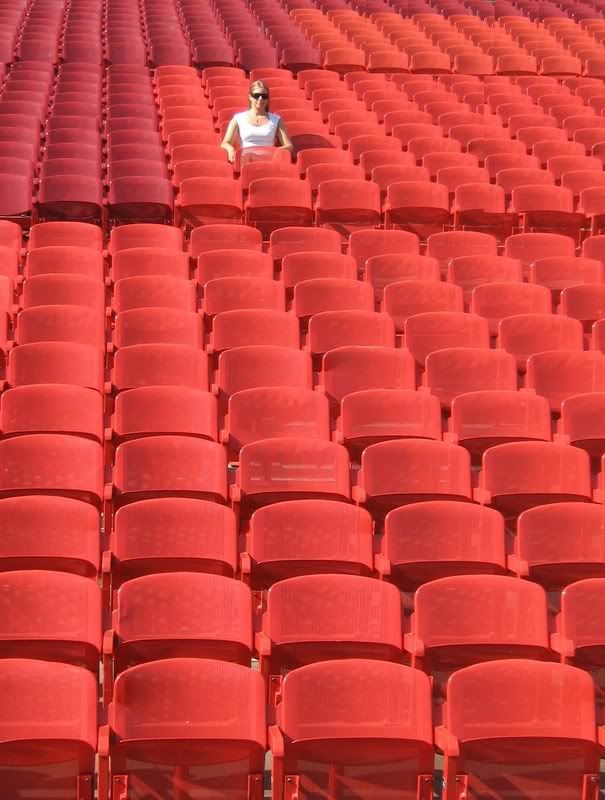 Monday 9th - Montagnana - The flood
Monday 9th - Montagnana - The floodOn monday, the day started almost as early as the day before, at a quarter to seven, as the connections to Verona from Montagnana are somewhat strange, giving you a chance in the very early morning and another in the very late morning, with nothing in between. That also meant that we didn't have time to have breakfast before boarding the train, but what was even worse was that, as I tried to get a shower, I realized the water was not being drained out of the small shower-cabin and, being that it had just a simply tent to divide it with the rest of the bathroom, the consequence was a flood.
Now, if it did ever happen to you to be half soaped up and having to stop everything, you will understand my feelings. If then you had to stop a flood at 7.00 am, with just a few hours of sleep on your back and a train, the only train you can get, leaving in 40 minutes, you have a general idea of the situation. If that never happened to you, i can tell you it's bad. I called the landlord (who was living just above us) and I evidently woke her up, I explained her the situation and that i couldn't wait for her to come down and we moved out.
Along the way and even more at the station I was surprised by the number of kids around, then I realized that day was the first school day of the year, meaning kids everywhere but without books with them. We did catch the train and even successfully switched train in this small station I forgot the name of and by 9 we were in Verona.
 Monday 9th - Verona- The "under work" city
Monday 9th - Verona- The "under work" cityVerona is a wonderful city laying along the Adige river, mostly known abroad for Shakespeare's play "Romeo and Juliet" and, less so, "The two gentlemen from Verona" and, among opera opera maniacs, for the majestic roman Arena. As many of the medieval cities of Italy, it was also the stage for the story of a noble family, the Della Scala or "Scaligers" in this case, with its own intrigues, loves, struggles for power, murders and, most important for the ones living today, monuments and the works of art they commissioned. Verona was also the city of Catullus. Plinius, Emilius Macro, Vitruvius and Cornelius Nepos.
 Our first stop was, passing through Porta Nuova (New gate) and Piazza Bra (the largest square of Verona, next to the Arena), at Castelvecchio, the city castle, famous for its bridge crossing the Adige (which was blown up by the retreating germans at the end of the WWII and rebuilt with the original bricks, recovered from the water one by one). Having quickly visited the courtyard and crossed the bridge, we moved along the river which we crossed again at the next bridge (from where the picture on the right was taken).
Our first stop was, passing through Porta Nuova (New gate) and Piazza Bra (the largest square of Verona, next to the Arena), at Castelvecchio, the city castle, famous for its bridge crossing the Adige (which was blown up by the retreating germans at the end of the WWII and rebuilt with the original bricks, recovered from the water one by one). Having quickly visited the courtyard and crossed the bridge, we moved along the river which we crossed again at the next bridge (from where the picture on the right was taken).Here, we saw that the most interesting of the palaces of Verona, il Palazzo della Ragione (The Reason's Palace) was totally covered for restoration works, included its high tower. Passing under an arcade surmounted by the rib of a whale, thought to be once upon a time the rib of a giant or of an angel, we got to the most characteristic of the city square, Piazza Dante, with its arcades and typically medieval facades... which were mostly covered, being under restoration. While we were giving a look around, a guided tour arrived and we mingled once again (the fact that Susanne and me, when together, speaking in english and looking so different, are often mistaken for americans helps a lot in mingling with touristic groups).

 There, the guide started to explain the difference between the two typical kind of battlements you can find in most of central and northern Italy medieval defensive works, the square and the "swallow tails" ones. Far from being a merely esthetical detail, the two different styles were a sign of the political siding of the city in the struggles between the Holy Roman Empire and the Papacy. So far, so good... if only the guide hadn't indicated as the reason for Verona to side with the Empire the being closer to Austria, clearly mixing the Holy Roman Empire with the Austro-Hungarian empire. We then moved on to Santa Maria Antica, the Scaligeri's own church and where their magnificent arks are... finding the most important one totally under cover as well and the whole area closed (right). The throne on the left is inside the church.
There, the guide started to explain the difference between the two typical kind of battlements you can find in most of central and northern Italy medieval defensive works, the square and the "swallow tails" ones. Far from being a merely esthetical detail, the two different styles were a sign of the political siding of the city in the struggles between the Holy Roman Empire and the Papacy. So far, so good... if only the guide hadn't indicated as the reason for Verona to side with the Empire the being closer to Austria, clearly mixing the Holy Roman Empire with the Austro-Hungarian empire. We then moved on to Santa Maria Antica, the Scaligeri's own church and where their magnificent arks are... finding the most important one totally under cover as well and the whole area closed (right). The throne on the left is inside the church. From Santa Maria Antica we decided to skip the alleged (and foul smelling, considering the habit people have taken to leave messages sticking them to the wall using chewing gum) "Juliet's house" and we headed towards Saint Anastasio, the largest city's church... which obviously we found with its whole right side under work as well, but at least with the most interesting parts visible, included the famous Pisanello's frescoes showing Saint George and the princess.
From Santa Maria Antica we decided to skip the alleged (and foul smelling, considering the habit people have taken to leave messages sticking them to the wall using chewing gum) "Juliet's house" and we headed towards Saint Anastasio, the largest city's church... which obviously we found with its whole right side under work as well, but at least with the most interesting parts visible, included the famous Pisanello's frescoes showing Saint George and the princess. Unfortunately the city's cathedral was closed due some taping that was going on inside, but we still took the chance of visiting its precious cloister and admiring the roman mosaics that have been found under the middle age buildings and taken to the light. After that, following the example of some people who arrived slightly after us, we decided to have our lunch there too, in the total silence of the place.
Unfortunately the city's cathedral was closed due some taping that was going on inside, but we still took the chance of visiting its precious cloister and admiring the roman mosaics that have been found under the middle age buildings and taken to the light. After that, following the example of some people who arrived slightly after us, we decided to have our lunch there too, in the total silence of the place.
 Now, if love has to be proved somehow, I can say that, after having rested a bit in the cloister, I did my fine share. Susanne wanted to see the roman theatre of Verona, which is on the side of a lovely hill (left), more or less at the mid of it. When, around two years ago, I was in Verona for the first time I simply refused to climb there. This time, not only I reached the place (which was closed) but I actually went the whole way up to the top of the hill where an austro-hungarian barracks stay guarding the city, at the time an important piece of the imperial fences in Italy. I must say that there was a great view from there, not to mention an hyper-classy-cool bar hidden away behind the barracks.
Now, if love has to be proved somehow, I can say that, after having rested a bit in the cloister, I did my fine share. Susanne wanted to see the roman theatre of Verona, which is on the side of a lovely hill (left), more or less at the mid of it. When, around two years ago, I was in Verona for the first time I simply refused to climb there. This time, not only I reached the place (which was closed) but I actually went the whole way up to the top of the hill where an austro-hungarian barracks stay guarding the city, at the time an important piece of the imperial fences in Italy. I must say that there was a great view from there, not to mention an hyper-classy-cool bar hidden away behind the barracks. Having descended the hill, we moved towards San Fermo, an interesting church that is actually two churches in one (an upper one and a much more ancient lower-level one beneath the first) displaying a perfect wooden ceiling "a carena" ("keel-like" because it looks vaguely as the keel of a ship) and then it was time to visit the Arena, which I had seen totally empty the first time and that today I could see in her summer version, when it is used for the Opera (left). And here, after having walked up and down the tribunes and galleries, my sportive girlfriend got cramps, worrying me no little.
Having descended the hill, we moved towards San Fermo, an interesting church that is actually two churches in one (an upper one and a much more ancient lower-level one beneath the first) displaying a perfect wooden ceiling "a carena" ("keel-like" because it looks vaguely as the keel of a ship) and then it was time to visit the Arena, which I had seen totally empty the first time and that today I could see in her summer version, when it is used for the Opera (left). And here, after having walked up and down the tribunes and galleries, my sportive girlfriend got cramps, worrying me no little.Having rested, we started to move back towards the station, visiting the peculiar (and hidden) church of San Lorenzo along the way, the triumph Arch of the Gavii and there I stopped again in the courtyard of the castle and drunk from a fountain, causing the harsh reaction of Susanne who thinks I'm crazy of drinking like that from fountains where it' s not specifically written the water is potable. Funny thing, this has been our first argument in italian (she's learning at an amazing pace which put my attempts to learn german to shame).
We got on the train and moved on and we did even managed to disembark at the right stop, which was quite a success. It should be known that there are two general rules that apply to little train station in Italy: first, their clock is generally broken and second, the signs with the name are either absent, unreadable or covered by vegetation. Montagnana station falls in both category and most specifically its clock is broken and the sign with the name is covered by a very nice tree so, being dark by the time we reached the station, it took a bit to understand we had indeed arrived.
 Monday 9th - Montagnana - The search for food
Monday 9th - Montagnana - The search for foodOnce disembarked, three were the main goals of the day: grocery shop for the morning after, which was duly done, finding an internet cafè, which was a failure, and having dinner. This proved to be more complicated than expected. if the night before we had seen several places open, we hadn't considered that monday evening is something totally different than sunday evening and in fact, by the time we hit the road in search for food, the city was a dark desert.
After having walked the whole city, which didn't take more than half a hour anyway), eventually, we settled for a kebab place, but the adventure was not over as we had quite some problems in having the owner of the place understand we needed a vegetarian kebab (in his defence, who does ever ask for a vegetarian kebab?) and eventually the result was slightly confused, with my own kebab having inside more vegetables than Susanne's one. Once home again (with the shower repaired and in order) and having finished eating, a yell resounded in the quiet of Montagnana: "HELL!!! We forgot to buy the toothpaste!" followed by a soothing reply: "Oh, well, we'll buy it tomorrow first thing in the morning". And the day was over.
Note about yesterday in Rome
Speaking of love tokens, yesterday Susanne wanted to do sports. Having been unable to find a badminton court and unsure about basketball, I eventually gave up and went jogging with her. My first attempt at jogging after years, after 2 months of scarce exercise (except the kilometers of marches of the previous week) and foolishly trying to keep her pace ended up with a dying me after just 20 minutes. In the evening, in the mid of yet another heavy lightining storm, we went to a Cameroon-style dinner following an invitation from someone I had, once upon a time, helped over the VCN mailing list. The dinner turned out to be quite interesting, both in regards of the food and the people attending.

3 comments:
*sigh* I definitely need to visit Italy sometime.
Anyhow, I do have to admit that my European History is a bit rusty, but was it actually incorrect of the guide to use "Austria" to refer to the Holy Roman Empire, particularly when Vienna served as its capital for a few hundred years?
P.S. Nitin is my roommate; he's like a brother to me.
This article was extremely interesting.
Hey - I am really glad to discover this. Good job!
Post a Comment